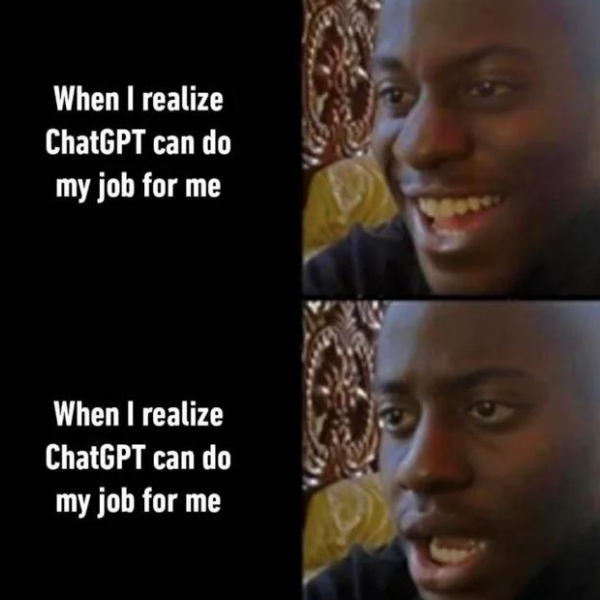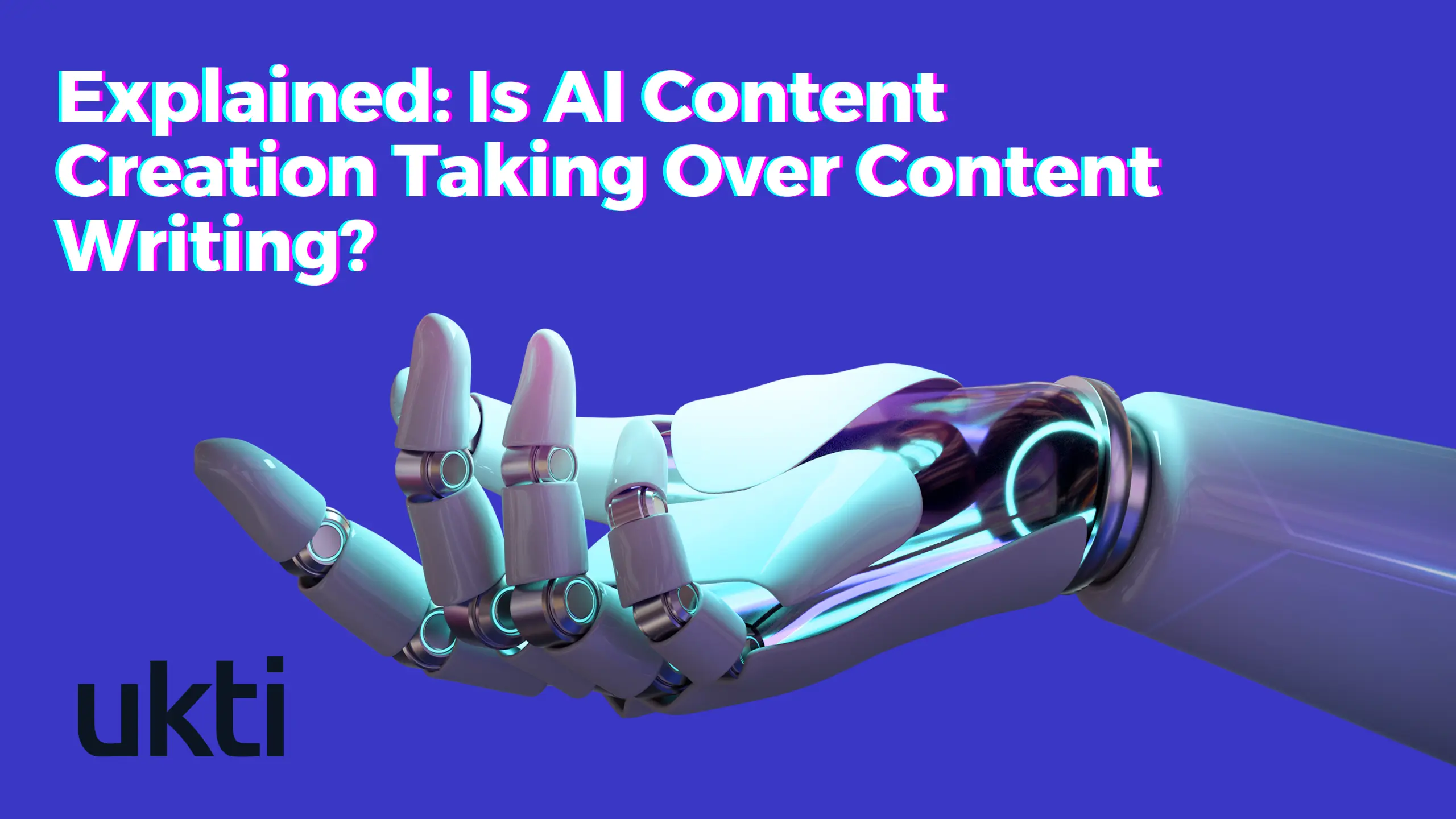“A billion people are set to lose their jobs due to AI takeover.”
“Can AI replace human writers?” How often have you come across similar headlines? Maybe every time you search for something AI-specific. But these headlines are just clickbait, half-baked truths designed to catch eyeballs.

Now, there is no denying that AI has influenced operations and jobs across industries. It surely has made completing many menial and repetitive work quick and convenient. But to say AI is going to replace an experienced and skilled executive?
You’ve got to be kidding. 🤡
However, concerns of AI takeover are real for many, and content writers are no different.
Many marketers are already relying on AI content creation for diverse content marketing efforts. Ever since AI content creation tools became sophisticated enough to put together blogs (even eBooks!) at unmatched speed and decent accuracy, they’ve become the talk of the town. But they’re definitely NOT taking over your job.
History of Content Bots: The Origin Story: Where Did Content Bots Come From?
No, because writers have unique ideas and expertise that no one else can convey, and definitely not a machine. So, your fears are 100% justified, but they’re also misplaced.
To make things clearer, let us now understand how exactly AI content creation tools create content.
How Do You Use AI in Content Creation?
AI content creation uses artificial intelligence and software to create content. But the process isn’t completely automated. It requires constant human input at various levels. Marketers typically have to enter all necessary data, descriptions, and other relevant details to generate the content.
That said, AI content creation tools can put together a blog, social copy, eBooks, listicles, emails, and even audio-visual content, at a remarkable speed. This is because of the underlying technologies at play.
Most AI content creation tools rely on two key technologies to generate content:
1. Natural Language Processing (NLP): Content creation tools use NLP to understand the spoken word. NLP is the same technology that’s used in automatic translation, speech recognition, and voice controls on smart devices. Currently, GPT-3 is the leading NLP tool used in writing articles, chatbots, and news reports.
2. Natural Language Generation (NLG): Content creation tools use NLG to turn structured data into written content. You can see NLG’s use in automated captions, chatbots, and weather reports.
To simplify: NLP processes human language. It is the reader who consumes and gathers information. Meanwhile, NLG is the writer. It generates content using the information NLP has gathered.
Together, NLP and NLG help machines learn and mimic human language’s genetics and create content that looks and reads like content written by humans in terms of tone, format, and characteristics. So it doesn’t take a genius to understand why the vast potential of AI content creation is as scary as it is intriguing.
So, Can AI Replace Content Writers? 👀

If you go over the process of AI content creation using NLP and NLG, you realise AI is not creating content of its own intelligence; it is rather assembling it using information fed into the software.
Writers, on the other hand, have personalities shaped by their unique experiences. This allows them to pen down a completely unique piece of content, irrespective of the information they have at hand.
The argument above may sound sentimental to your ears. And might not be good enough to persuade. But it’s true: AI content creation will not snatch your relevance. 👏
Here are four reasons why.
#1 AI-generated Content is Not Unique
Authenticity is the most demanded trait in a content writer, which Artificial Intelligence fails to achieve in the content it generates.
To generate content or content ideas, AI content creation tools rely on information already available on the Internet. They collect information available about the topic and put together blocks of text in a grammatically correct format.
But as you may already know, unique, original content needs more than just sound grammar. And this is where writers come to steal the show. They bring new angles, add insights, give examples, and offer personal opinions to make every piece of content unique.
#2 AI-generated Content May Be Outdated
Outdated content is a result of the AI content creation tools‘ inherent problem of relying on information available on the Internet.
Human civilization is changing rapidly, let it be industry, technology, society, or politics. And there is a gap between when changes occur and when the Google search algorithm catches up with them.
When you rely on AI tools to create content, you run the risk of obsoleteness. This is because the information they use will probably be outdated. And audiences who are directly affected by these changes or are at least aware of them will recognize the gap and may deem your content untrustworthy.
So, instead of increasing your audience, your content will suffer from high bounce rates and poor engagement metrics.
#3 AI Does Not Understand Context
AI takes information as it is and compiles it into sentences that are logical when read. However, it does not understand the historical and socio-political context of words and phrases it may use in the content it generates. In some cases, such content can be offensive and discriminatory, placing creators in trouble.
For example, when instructed to write content on Jews, people of colour, and women, GPT-3 generated content using sexist, racist, and biased language. The event led to Jerome Pesenti, head of the Facebook AI lab, calling GPT-3 “unsafe.”
Social platforms like Meta and YouTube are training AI to flag offensive material, but it is not perfect, not to mention a platform-specific effort. It may also take a long time before we see its application in AI content creation.
#4 Google Says No to AI Content Creation
According to Google’s Search Advocate, John Mueller, the search engine’s webmaster guidelines automatically consider AI-generated content as spam. For Google, such content is similar to shuffling words, using synonyms and translation. It is thus deemed spam and may even attract penalties.
At present, Google does not have an AI Detector system to detect AI-generated content without human assistance. John Mueller says if the web spam team comes across such content, they are authorized to take action. But it’s just the beginning of the crackdown. In the future, however, Google may even equip its system with an AI Detector tool to detect AI-generated content and hide it from search results automatically.
And this is huge! Most of us rely on Google’s services to search for topics and consume content. Since Google’s take on AI-generated content is clear, AI content creation is unlikely to take over the content writing industry.
What is the Right Way to Use AI for Content Creation?

Even though AI cannot replace human writers, it still has a lot to offer to the content creation process. The right approach would be to use AI to assist writers rather than trying to replace them.
For example, what is your editing process after you are done writing a piece of content? Most writers check it for grammatical errors and readability on tools like Grammarly and Hemmingway.
If you do, too, you must have come across suggestions that are not always correct. These tools get the basic structure of language right but often flag industry-specific terms or colloquial phrases, which takes the soul of the content away.
The inability of AI editing tools to understand nuance still maintains the importance of the role of editors and proofreaders. Similarly, AI content writing tools will not render content writers irrelevant. But they can assist writers in content creation.
Here are some useful applications of AI in content creation:
- Content Planning: AI content planning tools help writers research and analyse topics. Based on the information, they can prepare topic trees and content briefs in no time.
- Content optimization: Check spelling, grammar, and plagiarism.
- AI tools for SEO: AI tools can assist writers in keyword research and other SEO efforts, making their content easy to rank on Google searches. And the best part? Google’s new ‘Helpful Content Update’ isn’t penalising AI-generated content but guiding creators on how to use AI in content. So, the coast is clear for AI content creation.
Additional Read: Here is What Google’s Helpful Content Update Says About People-First Content
AI Content Creation is the Future
There is no denying the fact that AI has its uses in content creation and marketing; anyone saying otherwise may be out of touch with the world of tech and the content industry. However, AI content creation tools still have a long way to go before they can emulate a human writer. And even when they do, it would not be enough to replace writers.
There is no alternative to a writer’s wit, wisdom, and virtuoso. You can rely on AI to research topics and keywords, get quick translations, or find errors, but only a true content writer can influence a reader to click that CTA.
About the Author


6 thoughts on “Explained: Is AI Content Creation Taking Over Content Writing?”